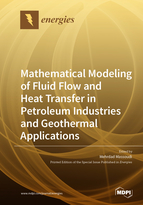Mathematical Modeling of Fluid Flow and Heat Transfer in Petroleum Industries and Geothermal Applications
A special issue of Energies (ISSN 1996-1073). This special issue belongs to the section "H: Geo-Energy".
Deadline for manuscript submissions: closed (31 October 2019) | Viewed by 78382
Special Issue Editor
2. Department of Mechanical Engineering, Carnegie Mellon University, Pittsburgh, PA 15213-3890, USA
Interests: multi-component flows; non-newtonian fluids; granular materials; heat transfer; mathematical modelling
Special Issue Information
Dear Colleagues,
Geothermal energy is the thermal energy generated and stored in the Earth's core, mantle and crust. Geothermal technologies are used to generate electricity and to heat and cool buildings. To develop accurate models for heat and mass transfer applications involving fluid flow in geothermal applications or reservoir engineering and petroleum industries, a basic knowledge of the rheological and the transport properties of the materials involved (for example, drilling fluid, rock properties, etc.), especially in high-temperature and high pressure environments, are needed. In this Special Issue, all aspects of fluid flow and heat transfer in geothermal applications, including the ground heat exchanger, conduction and convection in porous media are considered. The emphasis here will be on mathematical and computational aspects of fluid flow in conventional and unconventional reservoirs, geothermal engineering, fluid flow and heat transfer in drilling engineering and enhanced oil recovery (hydraulic fracturing, Steam-assisted gravity drainage (SAGD), CO2 injection, etc.) applications. Contributions in all these areas are welcome.
Prof. Dr. Mehrdad Massoudi
Guest Editor
Manuscript Submission Information
Manuscripts should be submitted online at www.mdpi.com by registering and logging in to this website. Once you are registered, click here to go to the submission form. Manuscripts can be submitted until the deadline. All submissions that pass pre-check are peer-reviewed. Accepted papers will be published continuously in the journal (as soon as accepted) and will be listed together on the special issue website. Research articles, review articles as well as short communications are invited. For planned papers, a title and short abstract (about 100 words) can be sent to the Editorial Office for announcement on this website.
Submitted manuscripts should not have been published previously, nor be under consideration for publication elsewhere (except conference proceedings papers). All manuscripts are thoroughly refereed through a single-blind peer-review process. A guide for authors and other relevant information for submission of manuscripts is available on the Instructions for Authors page. Energies is an international peer-reviewed open access semimonthly journal published by MDPI.
Please visit the Instructions for Authors page before submitting a manuscript. The Article Processing Charge (APC) for publication in this open access journal is 2600 CHF (Swiss Francs). Submitted papers should be well formatted and use good English. Authors may use MDPI's English editing service prior to publication or during author revisions.
Keywords
- Geothermal
- Heat exchangers
- Heat transfer
- Transport properties
- Mathematical modeling
- Computational Fluid Dynamics (CFD)
- Drilling
- Porous media
- Multiphase flow
- Conventional and unconventional reservoirs
- Enhanced oil recovery






